Stakeholder Relations, Corporate Governance and Ethics at Kathmandu
VerifiedAdded on 2022/08/21
|7
|1385
|14
Essay
AI Summary
This essay examines the stakeholder relations, corporate governance, and ethical practices of Kathmandu Holdings Limited, a multinational retail chain. The essay identifies and analyzes the company's internal and external stakeholders, including customers, employees, suppliers, factories, local communities, and shareholders. It explores Kathmandu's engagement strategies with each stakeholder group, highlighting the ethical issues raised and addressed. The essay emphasizes Kathmandu's commitment to ethical and professional behavior, aligning with corporate governance principles and sustainability goals. The company's B Corp certification underscores its dedication to environmental sustainability and social responsibility, ensuring a transparent supply chain and fair treatment of workers. The conclusion affirms Kathmandu's success in fostering high-quality stakeholder relationships and its commitment to ethical business practices.
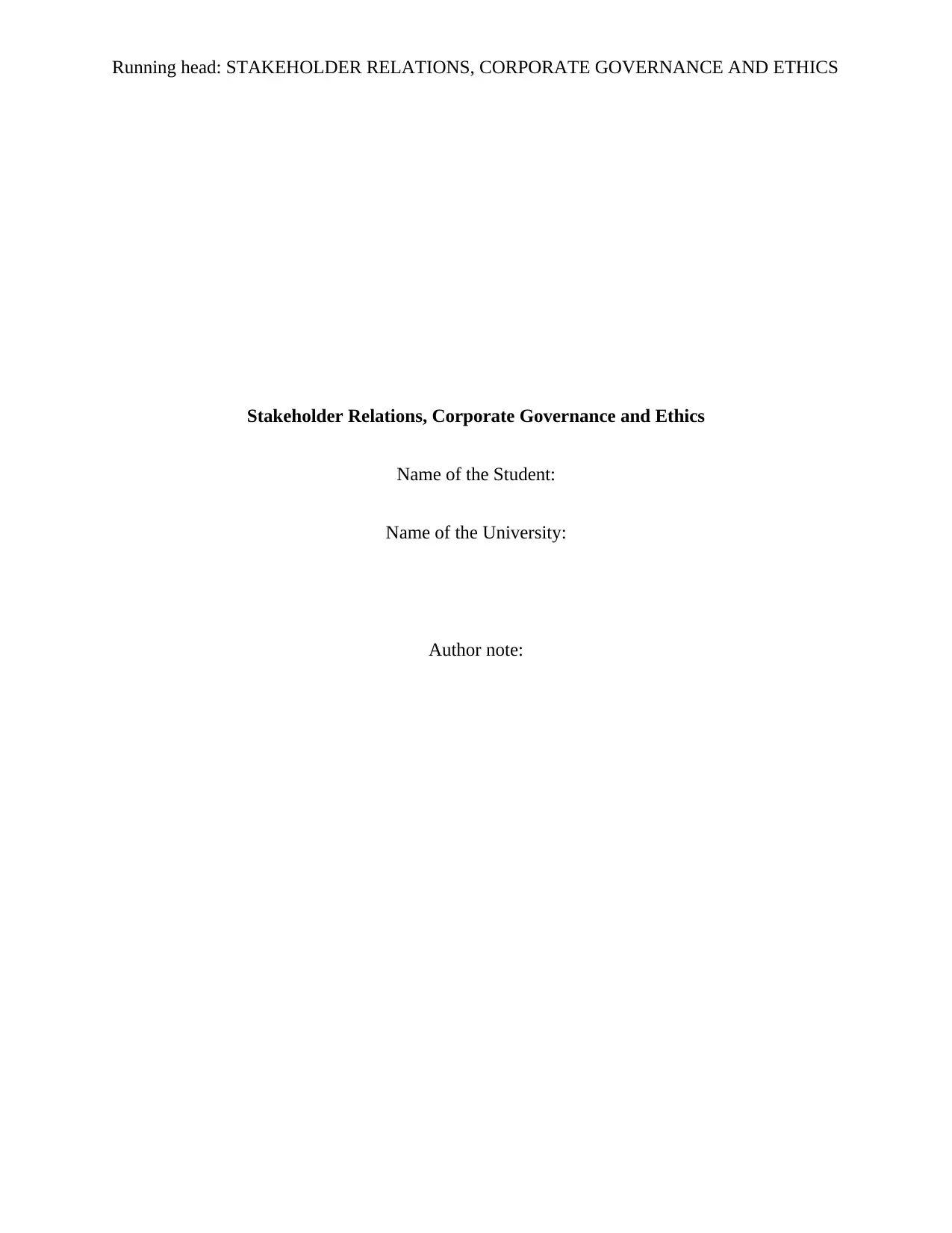
Running head: STAKEHOLDER RELATIONS, CORPORATE GOVERNANCE AND ETHICS
Stakeholder Relations, Corporate Governance and Ethics
Name of the Student:
Name of the University:
Author note:
Stakeholder Relations, Corporate Governance and Ethics
Name of the Student:
Name of the University:
Author note:
Paraphrase This Document
Need a fresh take? Get an instant paraphrase of this document with our AI Paraphraser
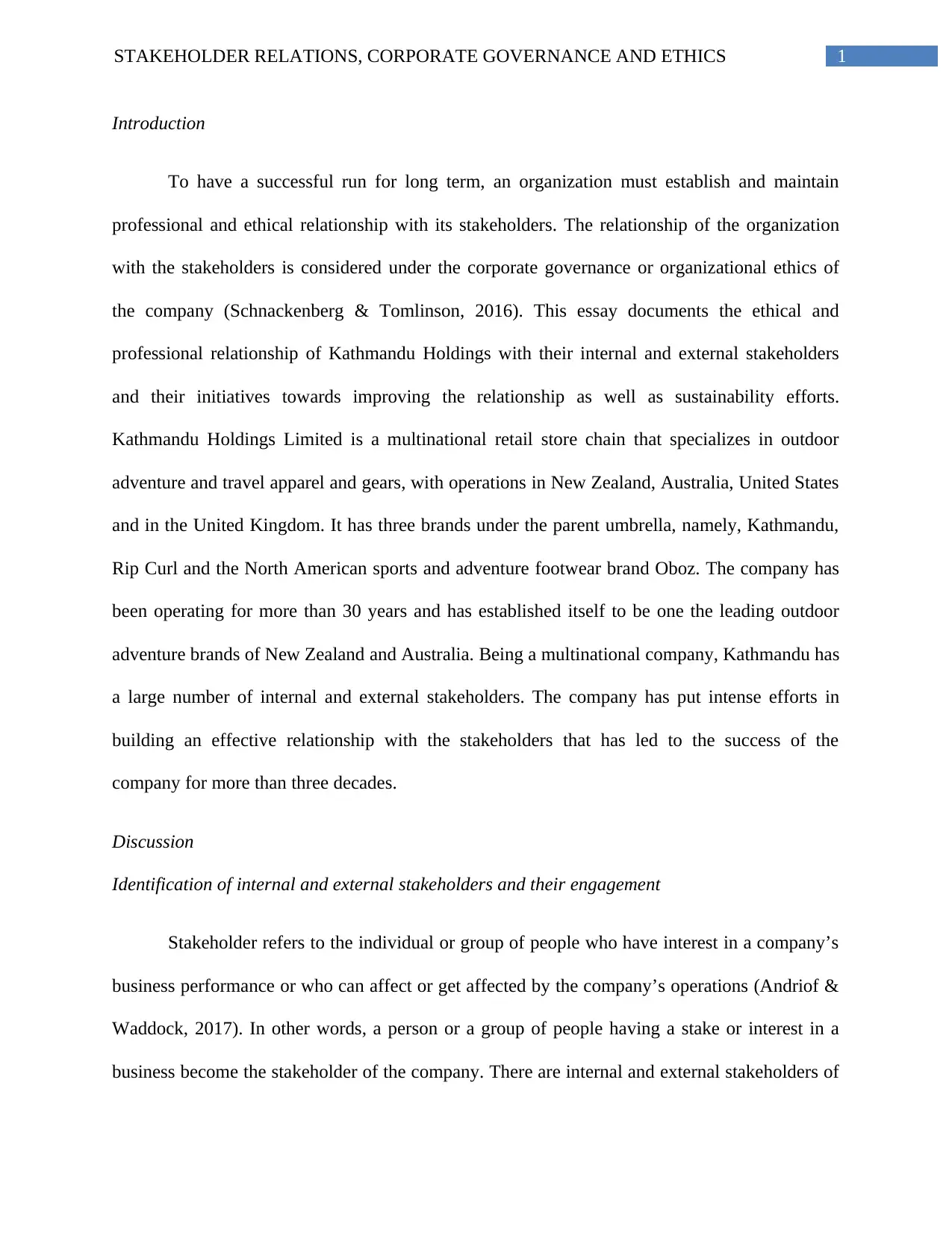
1STAKEHOLDER RELATIONS, CORPORATE GOVERNANCE AND ETHICS
Introduction
To have a successful run for long term, an organization must establish and maintain
professional and ethical relationship with its stakeholders. The relationship of the organization
with the stakeholders is considered under the corporate governance or organizational ethics of
the company (Schnackenberg & Tomlinson, 2016). This essay documents the ethical and
professional relationship of Kathmandu Holdings with their internal and external stakeholders
and their initiatives towards improving the relationship as well as sustainability efforts.
Kathmandu Holdings Limited is a multinational retail store chain that specializes in outdoor
adventure and travel apparel and gears, with operations in New Zealand, Australia, United States
and in the United Kingdom. It has three brands under the parent umbrella, namely, Kathmandu,
Rip Curl and the North American sports and adventure footwear brand Oboz. The company has
been operating for more than 30 years and has established itself to be one the leading outdoor
adventure brands of New Zealand and Australia. Being a multinational company, Kathmandu has
a large number of internal and external stakeholders. The company has put intense efforts in
building an effective relationship with the stakeholders that has led to the success of the
company for more than three decades.
Discussion
Identification of internal and external stakeholders and their engagement
Stakeholder refers to the individual or group of people who have interest in a company’s
business performance or who can affect or get affected by the company’s operations (Andriof &
Waddock, 2017). In other words, a person or a group of people having a stake or interest in a
business become the stakeholder of the company. There are internal and external stakeholders of
Introduction
To have a successful run for long term, an organization must establish and maintain
professional and ethical relationship with its stakeholders. The relationship of the organization
with the stakeholders is considered under the corporate governance or organizational ethics of
the company (Schnackenberg & Tomlinson, 2016). This essay documents the ethical and
professional relationship of Kathmandu Holdings with their internal and external stakeholders
and their initiatives towards improving the relationship as well as sustainability efforts.
Kathmandu Holdings Limited is a multinational retail store chain that specializes in outdoor
adventure and travel apparel and gears, with operations in New Zealand, Australia, United States
and in the United Kingdom. It has three brands under the parent umbrella, namely, Kathmandu,
Rip Curl and the North American sports and adventure footwear brand Oboz. The company has
been operating for more than 30 years and has established itself to be one the leading outdoor
adventure brands of New Zealand and Australia. Being a multinational company, Kathmandu has
a large number of internal and external stakeholders. The company has put intense efforts in
building an effective relationship with the stakeholders that has led to the success of the
company for more than three decades.
Discussion
Identification of internal and external stakeholders and their engagement
Stakeholder refers to the individual or group of people who have interest in a company’s
business performance or who can affect or get affected by the company’s operations (Andriof &
Waddock, 2017). In other words, a person or a group of people having a stake or interest in a
business become the stakeholder of the company. There are internal and external stakeholders of
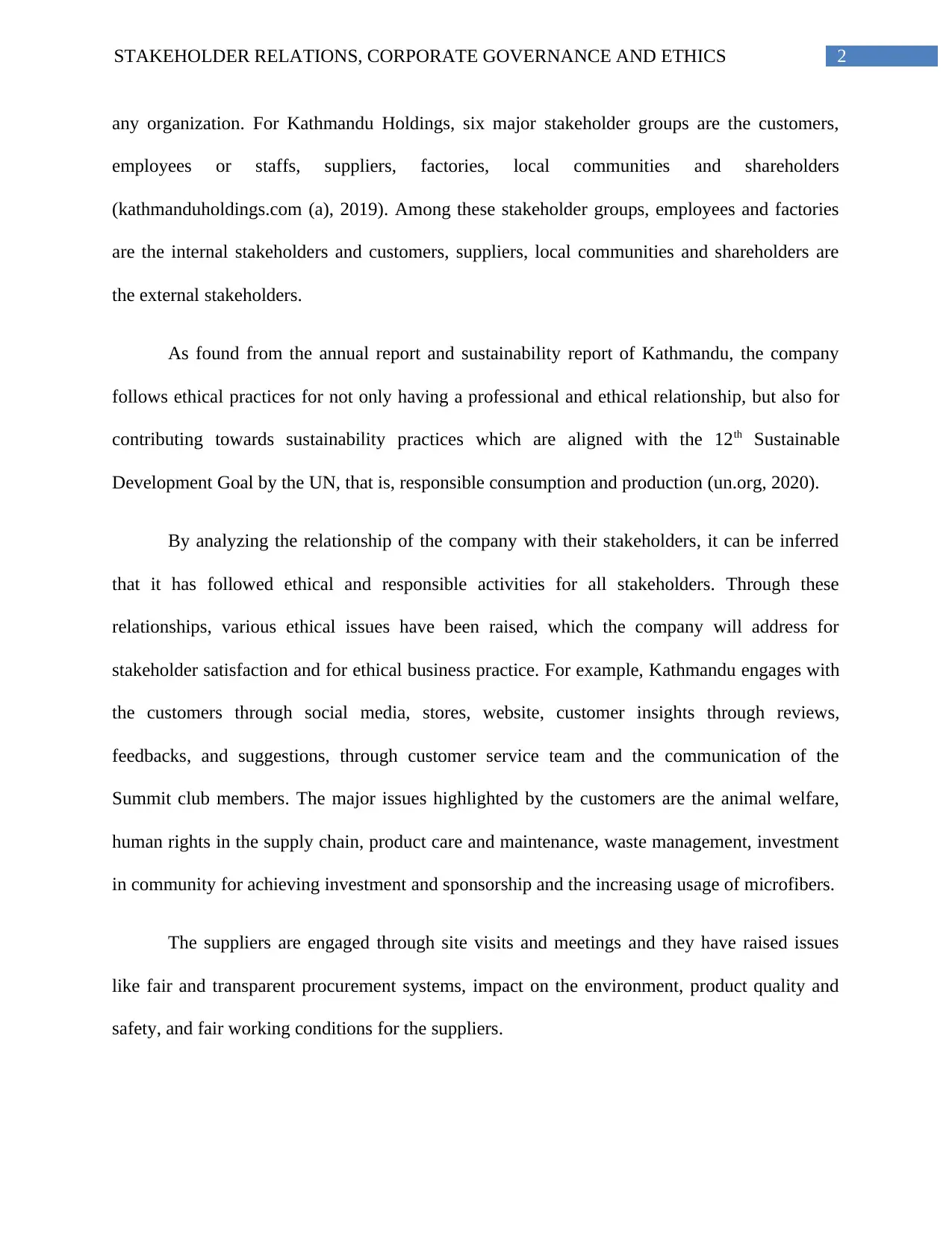
2STAKEHOLDER RELATIONS, CORPORATE GOVERNANCE AND ETHICS
any organization. For Kathmandu Holdings, six major stakeholder groups are the customers,
employees or staffs, suppliers, factories, local communities and shareholders
(kathmanduholdings.com (a), 2019). Among these stakeholder groups, employees and factories
are the internal stakeholders and customers, suppliers, local communities and shareholders are
the external stakeholders.
As found from the annual report and sustainability report of Kathmandu, the company
follows ethical practices for not only having a professional and ethical relationship, but also for
contributing towards sustainability practices which are aligned with the 12th Sustainable
Development Goal by the UN, that is, responsible consumption and production (un.org, 2020).
By analyzing the relationship of the company with their stakeholders, it can be inferred
that it has followed ethical and responsible activities for all stakeholders. Through these
relationships, various ethical issues have been raised, which the company will address for
stakeholder satisfaction and for ethical business practice. For example, Kathmandu engages with
the customers through social media, stores, website, customer insights through reviews,
feedbacks, and suggestions, through customer service team and the communication of the
Summit club members. The major issues highlighted by the customers are the animal welfare,
human rights in the supply chain, product care and maintenance, waste management, investment
in community for achieving investment and sponsorship and the increasing usage of microfibers.
The suppliers are engaged through site visits and meetings and they have raised issues
like fair and transparent procurement systems, impact on the environment, product quality and
safety, and fair working conditions for the suppliers.
any organization. For Kathmandu Holdings, six major stakeholder groups are the customers,
employees or staffs, suppliers, factories, local communities and shareholders
(kathmanduholdings.com (a), 2019). Among these stakeholder groups, employees and factories
are the internal stakeholders and customers, suppliers, local communities and shareholders are
the external stakeholders.
As found from the annual report and sustainability report of Kathmandu, the company
follows ethical practices for not only having a professional and ethical relationship, but also for
contributing towards sustainability practices which are aligned with the 12th Sustainable
Development Goal by the UN, that is, responsible consumption and production (un.org, 2020).
By analyzing the relationship of the company with their stakeholders, it can be inferred
that it has followed ethical and responsible activities for all stakeholders. Through these
relationships, various ethical issues have been raised, which the company will address for
stakeholder satisfaction and for ethical business practice. For example, Kathmandu engages with
the customers through social media, stores, website, customer insights through reviews,
feedbacks, and suggestions, through customer service team and the communication of the
Summit club members. The major issues highlighted by the customers are the animal welfare,
human rights in the supply chain, product care and maintenance, waste management, investment
in community for achieving investment and sponsorship and the increasing usage of microfibers.
The suppliers are engaged through site visits and meetings and they have raised issues
like fair and transparent procurement systems, impact on the environment, product quality and
safety, and fair working conditions for the suppliers.
⊘ This is a preview!⊘
Do you want full access?
Subscribe today to unlock all pages.

Trusted by 1+ million students worldwide
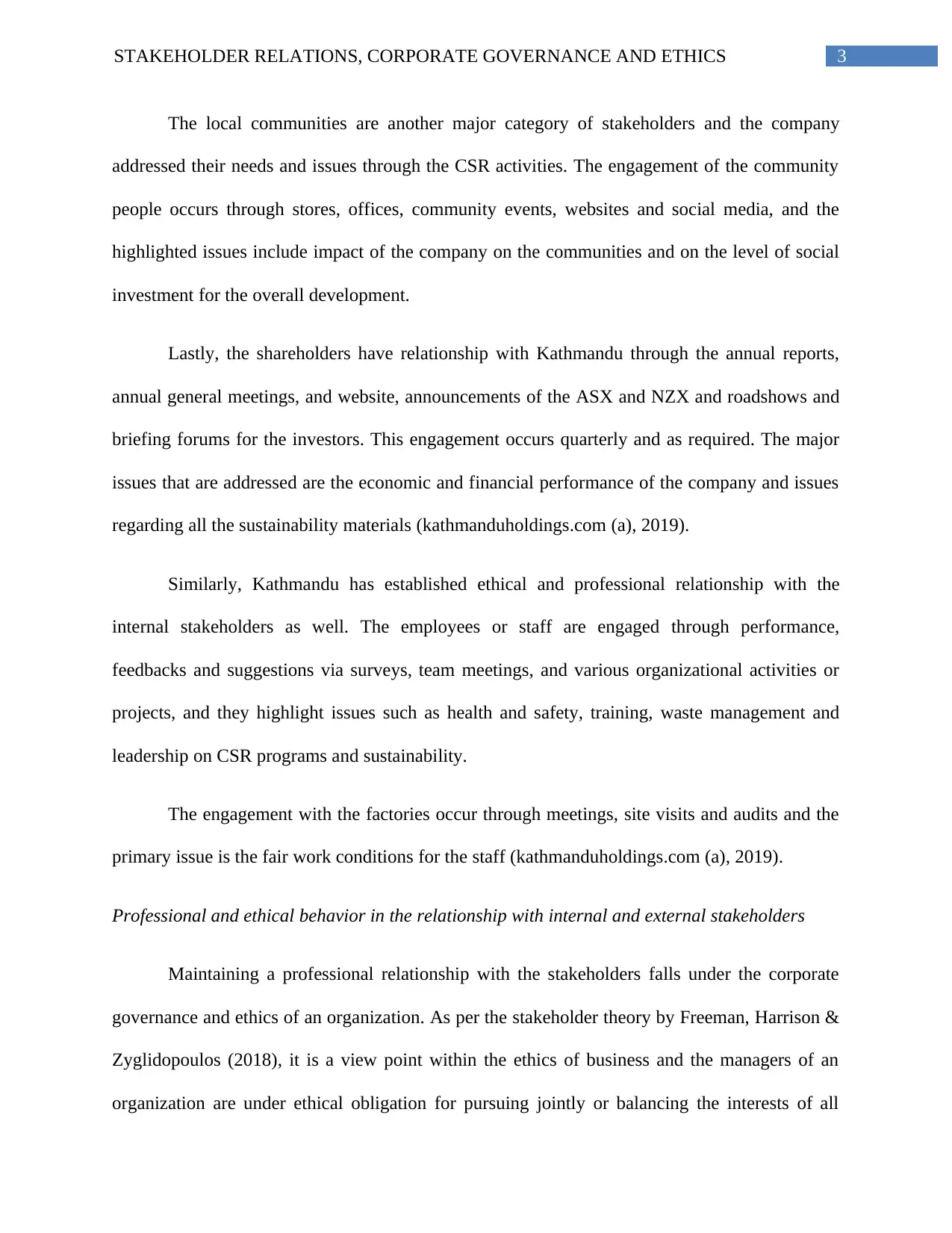
3STAKEHOLDER RELATIONS, CORPORATE GOVERNANCE AND ETHICS
The local communities are another major category of stakeholders and the company
addressed their needs and issues through the CSR activities. The engagement of the community
people occurs through stores, offices, community events, websites and social media, and the
highlighted issues include impact of the company on the communities and on the level of social
investment for the overall development.
Lastly, the shareholders have relationship with Kathmandu through the annual reports,
annual general meetings, and website, announcements of the ASX and NZX and roadshows and
briefing forums for the investors. This engagement occurs quarterly and as required. The major
issues that are addressed are the economic and financial performance of the company and issues
regarding all the sustainability materials (kathmanduholdings.com (a), 2019).
Similarly, Kathmandu has established ethical and professional relationship with the
internal stakeholders as well. The employees or staff are engaged through performance,
feedbacks and suggestions via surveys, team meetings, and various organizational activities or
projects, and they highlight issues such as health and safety, training, waste management and
leadership on CSR programs and sustainability.
The engagement with the factories occur through meetings, site visits and audits and the
primary issue is the fair work conditions for the staff (kathmanduholdings.com (a), 2019).
Professional and ethical behavior in the relationship with internal and external stakeholders
Maintaining a professional relationship with the stakeholders falls under the corporate
governance and ethics of an organization. As per the stakeholder theory by Freeman, Harrison &
Zyglidopoulos (2018), it is a view point within the ethics of business and the managers of an
organization are under ethical obligation for pursuing jointly or balancing the interests of all
The local communities are another major category of stakeholders and the company
addressed their needs and issues through the CSR activities. The engagement of the community
people occurs through stores, offices, community events, websites and social media, and the
highlighted issues include impact of the company on the communities and on the level of social
investment for the overall development.
Lastly, the shareholders have relationship with Kathmandu through the annual reports,
annual general meetings, and website, announcements of the ASX and NZX and roadshows and
briefing forums for the investors. This engagement occurs quarterly and as required. The major
issues that are addressed are the economic and financial performance of the company and issues
regarding all the sustainability materials (kathmanduholdings.com (a), 2019).
Similarly, Kathmandu has established ethical and professional relationship with the
internal stakeholders as well. The employees or staff are engaged through performance,
feedbacks and suggestions via surveys, team meetings, and various organizational activities or
projects, and they highlight issues such as health and safety, training, waste management and
leadership on CSR programs and sustainability.
The engagement with the factories occur through meetings, site visits and audits and the
primary issue is the fair work conditions for the staff (kathmanduholdings.com (a), 2019).
Professional and ethical behavior in the relationship with internal and external stakeholders
Maintaining a professional relationship with the stakeholders falls under the corporate
governance and ethics of an organization. As per the stakeholder theory by Freeman, Harrison &
Zyglidopoulos (2018), it is a view point within the ethics of business and the managers of an
organization are under ethical obligation for pursuing jointly or balancing the interests of all
Paraphrase This Document
Need a fresh take? Get an instant paraphrase of this document with our AI Paraphraser
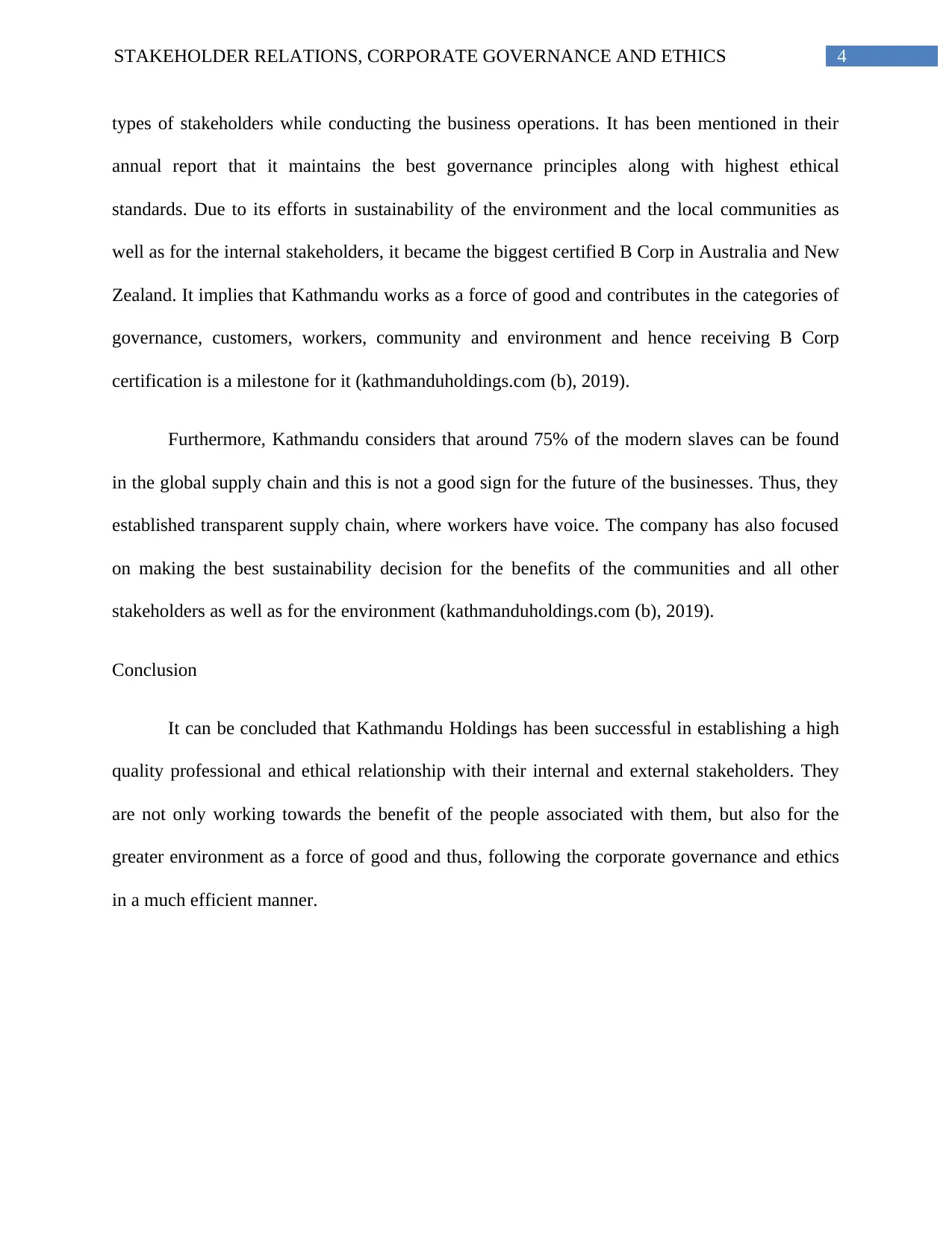
4STAKEHOLDER RELATIONS, CORPORATE GOVERNANCE AND ETHICS
types of stakeholders while conducting the business operations. It has been mentioned in their
annual report that it maintains the best governance principles along with highest ethical
standards. Due to its efforts in sustainability of the environment and the local communities as
well as for the internal stakeholders, it became the biggest certified B Corp in Australia and New
Zealand. It implies that Kathmandu works as a force of good and contributes in the categories of
governance, customers, workers, community and environment and hence receiving B Corp
certification is a milestone for it (kathmanduholdings.com (b), 2019).
Furthermore, Kathmandu considers that around 75% of the modern slaves can be found
in the global supply chain and this is not a good sign for the future of the businesses. Thus, they
established transparent supply chain, where workers have voice. The company has also focused
on making the best sustainability decision for the benefits of the communities and all other
stakeholders as well as for the environment (kathmanduholdings.com (b), 2019).
Conclusion
It can be concluded that Kathmandu Holdings has been successful in establishing a high
quality professional and ethical relationship with their internal and external stakeholders. They
are not only working towards the benefit of the people associated with them, but also for the
greater environment as a force of good and thus, following the corporate governance and ethics
in a much efficient manner.
types of stakeholders while conducting the business operations. It has been mentioned in their
annual report that it maintains the best governance principles along with highest ethical
standards. Due to its efforts in sustainability of the environment and the local communities as
well as for the internal stakeholders, it became the biggest certified B Corp in Australia and New
Zealand. It implies that Kathmandu works as a force of good and contributes in the categories of
governance, customers, workers, community and environment and hence receiving B Corp
certification is a milestone for it (kathmanduholdings.com (b), 2019).
Furthermore, Kathmandu considers that around 75% of the modern slaves can be found
in the global supply chain and this is not a good sign for the future of the businesses. Thus, they
established transparent supply chain, where workers have voice. The company has also focused
on making the best sustainability decision for the benefits of the communities and all other
stakeholders as well as for the environment (kathmanduholdings.com (b), 2019).
Conclusion
It can be concluded that Kathmandu Holdings has been successful in establishing a high
quality professional and ethical relationship with their internal and external stakeholders. They
are not only working towards the benefit of the people associated with them, but also for the
greater environment as a force of good and thus, following the corporate governance and ethics
in a much efficient manner.
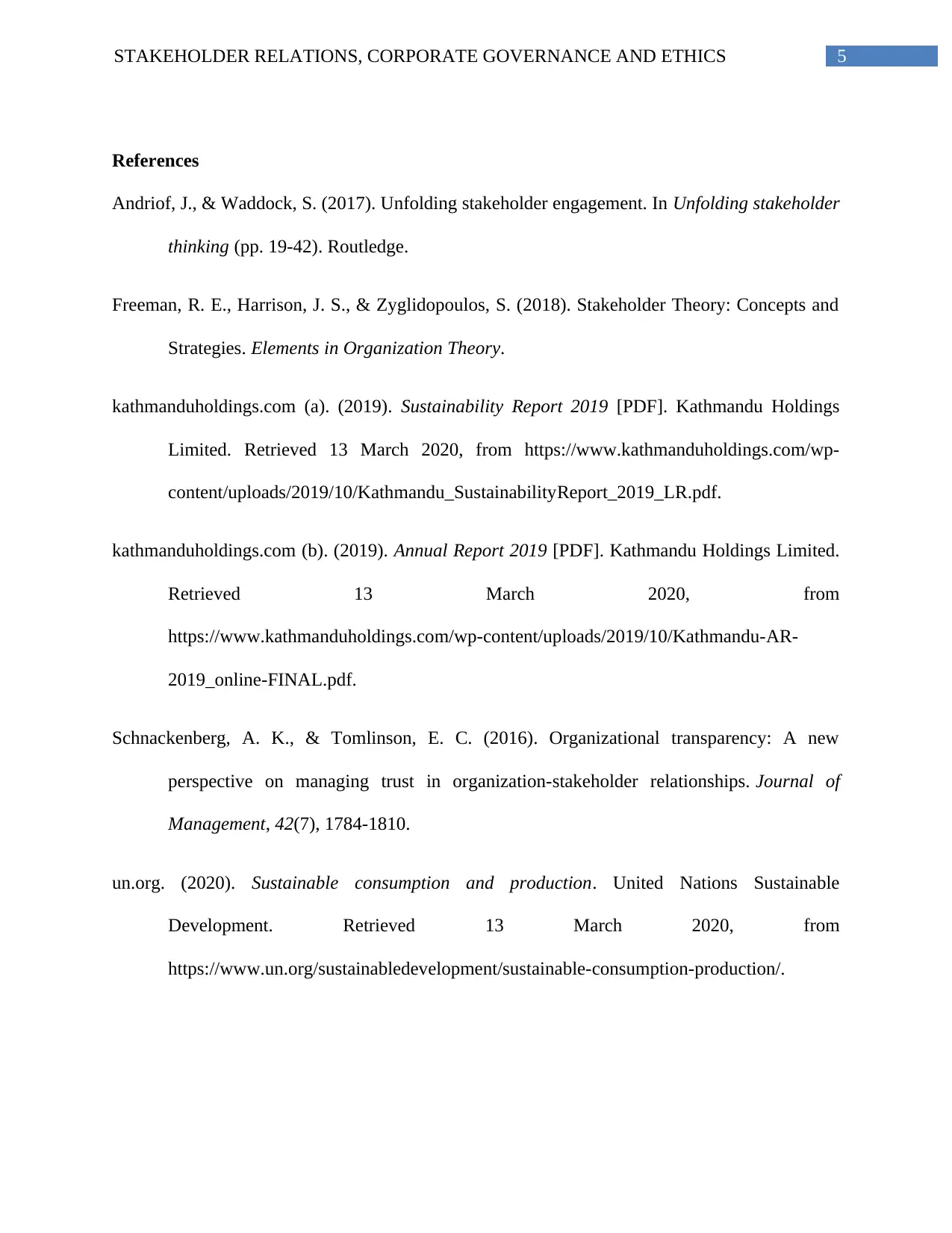
5STAKEHOLDER RELATIONS, CORPORATE GOVERNANCE AND ETHICS
References
Andriof, J., & Waddock, S. (2017). Unfolding stakeholder engagement. In Unfolding stakeholder
thinking (pp. 19-42). Routledge.
Freeman, R. E., Harrison, J. S., & Zyglidopoulos, S. (2018). Stakeholder Theory: Concepts and
Strategies. Elements in Organization Theory.
kathmanduholdings.com (a). (2019). Sustainability Report 2019 [PDF]. Kathmandu Holdings
Limited. Retrieved 13 March 2020, from https://www.kathmanduholdings.com/wp-
content/uploads/2019/10/Kathmandu_SustainabilityReport_2019_LR.pdf.
kathmanduholdings.com (b). (2019). Annual Report 2019 [PDF]. Kathmandu Holdings Limited.
Retrieved 13 March 2020, from
https://www.kathmanduholdings.com/wp-content/uploads/2019/10/Kathmandu-AR-
2019_online-FINAL.pdf.
Schnackenberg, A. K., & Tomlinson, E. C. (2016). Organizational transparency: A new
perspective on managing trust in organization-stakeholder relationships. Journal of
Management, 42(7), 1784-1810.
un.org. (2020). Sustainable consumption and production. United Nations Sustainable
Development. Retrieved 13 March 2020, from
https://www.un.org/sustainabledevelopment/sustainable-consumption-production/.
References
Andriof, J., & Waddock, S. (2017). Unfolding stakeholder engagement. In Unfolding stakeholder
thinking (pp. 19-42). Routledge.
Freeman, R. E., Harrison, J. S., & Zyglidopoulos, S. (2018). Stakeholder Theory: Concepts and
Strategies. Elements in Organization Theory.
kathmanduholdings.com (a). (2019). Sustainability Report 2019 [PDF]. Kathmandu Holdings
Limited. Retrieved 13 March 2020, from https://www.kathmanduholdings.com/wp-
content/uploads/2019/10/Kathmandu_SustainabilityReport_2019_LR.pdf.
kathmanduholdings.com (b). (2019). Annual Report 2019 [PDF]. Kathmandu Holdings Limited.
Retrieved 13 March 2020, from
https://www.kathmanduholdings.com/wp-content/uploads/2019/10/Kathmandu-AR-
2019_online-FINAL.pdf.
Schnackenberg, A. K., & Tomlinson, E. C. (2016). Organizational transparency: A new
perspective on managing trust in organization-stakeholder relationships. Journal of
Management, 42(7), 1784-1810.
un.org. (2020). Sustainable consumption and production. United Nations Sustainable
Development. Retrieved 13 March 2020, from
https://www.un.org/sustainabledevelopment/sustainable-consumption-production/.
⊘ This is a preview!⊘
Do you want full access?
Subscribe today to unlock all pages.

Trusted by 1+ million students worldwide
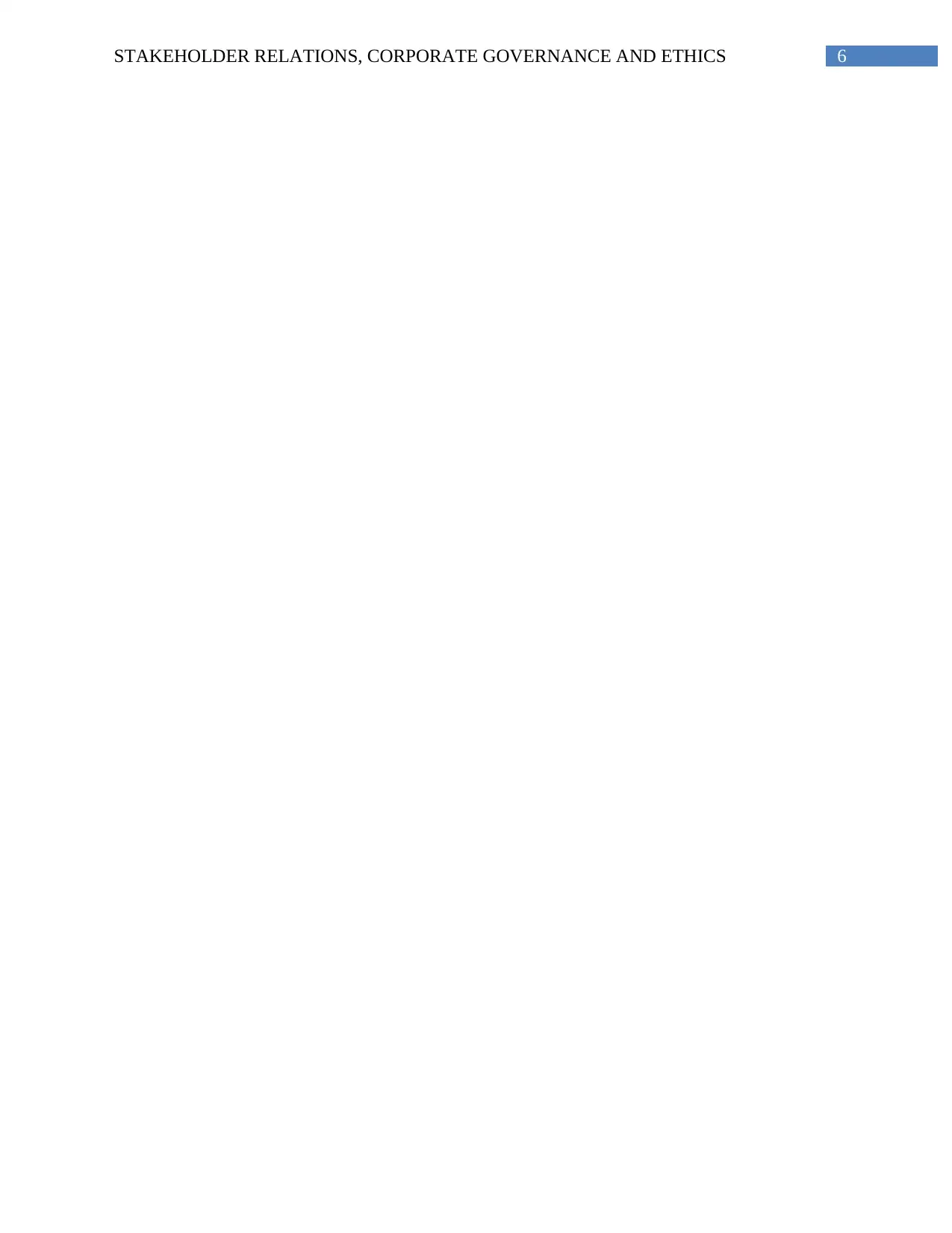
6STAKEHOLDER RELATIONS, CORPORATE GOVERNANCE AND ETHICS
1 out of 7
Related Documents
Your All-in-One AI-Powered Toolkit for Academic Success.
+13062052269
info@desklib.com
Available 24*7 on WhatsApp / Email
![[object Object]](/_next/static/media/star-bottom.7253800d.svg)
Unlock your academic potential
Copyright © 2020–2025 A2Z Services. All Rights Reserved. Developed and managed by ZUCOL.





